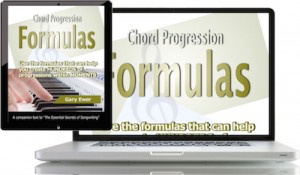Songwriting formulas are usually spoken of in a negative way. That’s because inherent in the term “formula” is the notion that if you do certain things, you’ll get a predictable result. And if you’re like most songwriters, “predictable” is not what you’re after.
There are many kinds of formulas that are used in songwriting. Some formulas, for example, refer to the form of the song. The verse-chorus-bridge design is a kind of formula that says you’ll write a verse and chorus, follow it with a second verse and chorus, and then move on to the bridge, and so on.
 In the eBook “Chord Progression Formulas”, you’ll find one-page formula diagrams that allow you to create dozens of different chord progressions within moments. A must-have manual especially designed for chords-first songwriters. Get it separately, or as part of “The Essential Secrets of Songwriting 10-eBook Bundle.”
In the eBook “Chord Progression Formulas”, you’ll find one-page formula diagrams that allow you to create dozens of different chord progressions within moments. A must-have manual especially designed for chords-first songwriters. Get it separately, or as part of “The Essential Secrets of Songwriting 10-eBook Bundle.”
There’s nothing innocuous about that kind of formula. Where they become a bad thing is when the specifics of songs are determined, and you really start to notice a predictability with the song.
An example? Let’s say every song you write starts with a rhythmic percussion intro, then moves on to a melody that sits very low in the vocalist’s range. From there, you start a pre-chorus section that requires the singer to suddenly jump up an octave and sing short, staccato notes while the chord progression goes back and forth from Am to G. Then you get a loud, high-pitched melody for a chorus, and so on.
If most of your songs do this, you’ve got a problem: no matter how good your song is, your listeners will start to feel that they’ve heard it all before. And even though none of the melodies or lyrics are the same as anything else you’ve written, the basic structure of your music is following a pattern — a formula — that you’ve used before.
But there is one kind of songwriting formula where predictability is not necessarily a bad thing, and it’s chord progression formulas.
When we judge a song for its imaginative and creative approach, we don’t necessarily extend that need for innovation to the chord progressions it uses. In other words, as long as your melodies and lyrics are fresh and interesting, and change things like tempo, key, instrumentation, etc., it can all be built upon a tried and true, well-used chord progressions, the ones you might hear in many other songs.
This is not to say that interesting chords are not welcome. When The Beatles first started out, they were known for innovative chord progressions. It’s not that their chords were strange or cutting edge, but when compared to progressions you’d hear in other pop songs of the day, there were more of them. A typical early- to mid-sixties pop song might use four or five chords in their progressions, while The Beatles and other groups were using progressions that used seven or eight or more.
A chord progression formula simply says “When you use this chord, you’ll probably then play that chord.” And in fact, the closer you get to the end of a progression, the more predictable it becomes.
So let’s say you create a progression that starts with these three chords: C – Am – Dm. Once you’ve heard those three chords, it seems likely that the next chord will be a G. And if not a G, then probably an F. Allowing for that kind of predictability is a main feature of a chord progression formula.
When you feel compelled to use a certain chord over other possibilities, you’re using a chord progression formula. And as I say, there’s nothing really wrong with that. A chord progression formula will not ruin your song, because we tend to judge the quality of other aspects of a song (melody, lyrics, instrumental ideas, etc.) before we point the finger at a progression.
Just a reminder that this is not a warning to stay away from innovative chord progressions. But if you are stuck at the chord progression stage of songwriting, just make sure you’ve got something that works, and don’t worry if it’s a progression that’s been used many times before. Chord progression formulas can be a quick fix that gets you writing songs more quickly.
 Written by Gary Ewer. Follow Gary on Twitter.
Written by Gary Ewer. Follow Gary on Twitter.
 The perfect combination: “The Essential Secrets of Songwriting 10-eBook Bundle” and a Study Guide! Dig into the songwriting manuals that thousands of songwriters are using to polish their technique, complete with a study guide to show you how to progress through the materials.
The perfect combination: “The Essential Secrets of Songwriting 10-eBook Bundle” and a Study Guide! Dig into the songwriting manuals that thousands of songwriters are using to polish their technique, complete with a study guide to show you how to progress through the materials.










